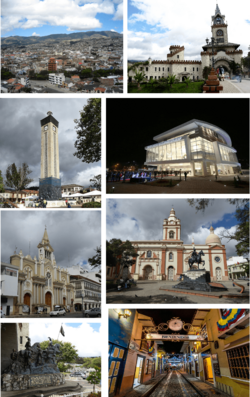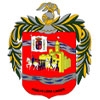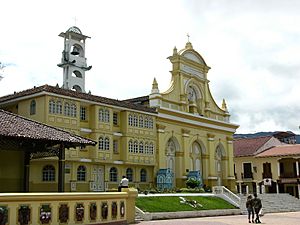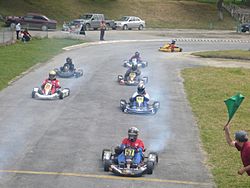Loja, Ecuador facts for kids
Quick facts for kids
Loja
|
|||
|---|---|---|---|
|
City
|
|||

From top, left to right: Panoramic view of the city, City Gate, Loja Independence Monument, Benjamín Carrión National Theater, Cathedral of the Shrine, Saint Francis Church next to the Alonso de Mercadillo monument, Juan de Salinas monument and Lourdes street.
|
|||
|
|||
| Nickname(s):
"Musical Capital of Ecuador"
|
|||
| Motto(s):
Loja Para Todos (Loja is for Everyone)
|
|||
| Country | |||
| Province | |||
| Canton | Loja | ||
| Founded | December 8, 1548 | ||
| Area | |||
| • City | 55.88 km2 (21.58 sq mi) | ||
| Elevation | 2,060 m (6,758 ft) | ||
| Population
(2022 census)
|
|||
| • City | 203,496 | ||
| • Density | 3,641.7/km2 (9,431.9/sq mi) | ||
| Demonym(s) | Lojano/a | ||
| Time zone | UTC-5 (ECT) | ||
| Postal code |
110101, 110102, 110103, 110104
|
||
| Area code(s) | (+593) 7 | ||
| Climate | Cfb | ||
| Website | www.loja.gob.ec/ | ||
Loja is an important city in Ecuador. It is the capital of the Loja Province. The city is located in a beautiful valley called Cuxibamba, in the south of Ecuador. It shares borders with the Zamora-Chinchipe Province. Loja is famous for its strong traditions in music and arts. For this reason, it is known as the "Music and Cultural Capital of Ecuador." The city is also home to two major universities.
About 203,000 people live in Loja. The city is high up, about 2,060 meters (6,758 feet) above sea level. It has a mild climate, usually between 16 and 30 degrees Celsius. The main road called the Pan-American Highway passes by Loja.
Contents
History of Loja
The city of Loja was founded by Alonso de Mercadillo in 1548. It was named after his hometown of Loja in Spain. The city was first built in 1546 near the Catamayo canyon. But after a big earthquake and problems with Malaria, it was moved to its current spot. This new location is about 35 kilometers (22 miles) east.
Loja is almost 500 years old, making it one of the oldest cities in Ecuador. The Spanish built it as a strong town near the Zaruma region, which had a lot of gold back then. It was also a starting point for trips into the Amazon Basin to search for the legendary city of El Dorado.
The famous leader Simón Bolívar visited Loja during his efforts to unite Gran Colombia. Loja declared its independence from Spain on November 18, 1820. Loja was also the first city in Ecuador to get electric power. This power came from a hydroelectric dam built in the 1890s.
Geography and Climate
Loja is located at the bottom of a wide valley called Cuxibamba. The area is between the wet Amazon Basin and the dry Peruvian sechura desert. It has different types of nature, like high grasslands (paramo), cloud-forests, and jungles.
The valley is next to the Podocarpus National Park. This park is a huge cloud-forest reserve. You can enter it through the Cajanuma gates, which are just a few minutes outside the city. The Rio Zamora and Rio Malacatos rivers flow through Loja.
Loja's Weather
Loja has a mild climate. Days are generally warm, and nights are cooler and often wetter. The average temperature is about 16°C (61°F). In June and July, there is often a light rain and strong winds. This time is known as the "windy season." Because it's in a valley, the city is often misty in the morning, but it usually clears up by the afternoon.
Economy and Industry
Loja is the capital of one of Ecuador's main coffee-growing areas. This means a lot of coffee comes from this province.
Near Loja, you can find Ecuador's first wind farm. This is a place where wind turbines use wind to create electricity. It has a visitors center and 11 large generators.
Arts and Culture
Loja has a lively music scene, which fits its reputation as a musical city. There are many small music and salsa clubs. It's common to hear people from Loja singing as they go about their day. On Sundays, the local police band plays music in the Plaza de Independencia, outside San Sebastian Church.
The city is full of public art. You can see huge painted tile murals, frescoes (paintings on wet plaster), and statues. The frescoes of Bolívar and Sucre are especially notable. They greet visitors as they pass through the city gates.
Many famous thinkers and writers were born in Loja. These include Pablo Palacio, Benjamín Carrión, Miguel Riofrío, and Ángel Felicísimo Rojas.
Annual Cultural Events
Loja hosts several important events each year:
- May 30 - August 15: The Pilgrimage of the Virgin of El Cisne.
- June 25: Celebration of the founding of Loja Province.
- September 1–15: The Ecuador-Peru Border Integration Fair.
- November 1: The Virgin of Cisne returns to the town of El Cisne.
- November 18: Celebration of Loja's Independence.
- December 8: Celebration of Loja's founding.
Points of Interest
- Puerta de la Ciudad (City Gates)
The city gates look like Loja's coat of arms, which was given by King Philip II of Spain in 1571. The gate is on Av. Gran Colombia. Inside, there are four galleries showing local artwork, plus a cafeteria and gift shop.
Loja has many historic churches. The city's tourism board has a fun way to help visitors find them. Starting at the Puerta de la Ciudad, you'll see a large orange stripe painted on the sidewalk. If you follow this stripe, it will lead you on a self-guided tour of Loja's main historic churches and areas.
- Cathedral
The main Cathedral is built in the colonial style and is located on the central square. For six months of the year, it is home to the Virgin of Cisne statue. This statue is carried by faithful people to and from the town of Cisne, which is 45 kilometers (28 miles) north of Loja. This procession closes the road twice a year, and it's a proud tradition for people from Loja to join in. Parts of the original adobe building date back to the 1500s. The current building was finished in 1838 because earlier ones were destroyed by earthquakes. The Cathedral is one of the largest churches in Ecuador and is the main church for the Roman Catholic Diocese of Loja.
- Church of San Francisco
This smaller church houses the city's Franciscan convent. The church was first built in 1548 and then rebuilt in 1851. In the plaza outside, you'll see a monument to Alonso de Mercadillo, who founded the city.
- Church of Santo Domingo
The Church of Santo Domingo was built in 1557. It used to be entirely in the Gothic style. But after an earthquake in 1867, only its two tall spires were left standing. The church was rebuilt in the colonial style, but the spires were kept to remind people of its original look. A famous artist from Loja, Fray Enrique Mideros, painted and decorated the church. In the church's plaza, there is a monument to Manuel Carrión Pinzano, who helped start the Federalism movement in Loja in 1853.
- Church of San Sebastian
In 1660, the city of Loja was dedicated to St. Sebastian to protect it from earthquakes. The current church was built in 1900. One of Loja's most famous landmarks is in Plaza San Sebastian (also called the Plaza of Independence). It's a 32-meter (105-foot) clock tower that remembers Loja's declaration of independence from Spain on November 18, 1820. The tower has four sides with brass carvings showing scenes from the city's history.
- Monuments
Loja has many other monuments honoring famous people from Loja and Ecuador. In Central Square, there's a monument to Bernardo Valdivieso, who founded Loja's universities. A monument to Bolívar is in a park named after him, remembering his visit to Loja in October 1822.
Sports
Loja is home to Liga de Loja, a major football (soccer) team. They play in Ecuador's professional football league.
Parks and Recreation
There are three notable parks within the city and a botanical garden just outside.
- Jipiro Park
In the north of the city, Jipiro Park covers over 10 hectares (25 acres). It is home to various native bird species. The park is special because it has smaller versions of famous historic and cultural buildings from around the world. You can see a pagoda, a mosque, St. Basil's cathedral, a medieval castle, and more. There's also a lake where you can go paddle-boating, with an island for birds.
- La Banda Park
Next to Jipiro, along the Rio Zamora, is a large green space. It has a public carting (go-kart) race track, riding trails, an orchid nursery, and the Loja zoo.
- Parque Pucará de Podocarpus
This park is on a hill called Pucará de Podocarpus. It's a children's park with playground equipment and a beautiful view of the city. It's located where the city's old drinking water treatment plant used to be.
- Jardín Botánico Reinaldo Espinosa
Across the road from University Park is the botanical garden. It's open to the public and is the oldest botanical garden in Ecuador, created in 1949. It has over 800 different kinds of native and foreign plants. It's like a living laboratory for science and learning about the environment. It covers 7 hectares (17 acres) and is divided into 5 sections for visitors to explore. Most of the trees in this garden are over 40 years old. It's also one of the highest-altitude botanical gardens in the world.
- Parque Universitario de Educación Ambiental y Recreación "Francisco Vivar Castro"
This park is about 5 kilometers (3 miles) south of central Loja, opposite the Botanical Gardens. It covers 90 hectares (222 acres) and has hiking trails, camping areas, and classrooms for environmental education.
Education
Loja has some of the best universities in Ecuador. The Universidad Técnica Particular de Loja (UTPL) is one of the top three in the country. It offers both on-campus and distance learning in many subjects. These include Architecture, Medicine, Communications, Law, and many types of Engineering.
In 2007, UTPL started using an academic system similar to the European System of Credit Transfer (ECTS). This system helps measure how much students learn and the skills they gain. This university works with many universities around the world, like the University of California at San Diego and the University of Frankfurt. UTPL also has three international campuses in New York (USA), Madrid (Spain), and Rome (Italy).
Another excellent school, ranked in the top 10 nationally, is the Universidad Nacional de Loja. It offers programs in Law, Education, Medicine, and Fine Arts, among others. The Loja campus of the Universidad Internacional del Ecuador works with Harvard University. It offers degrees like Business Engineering, Marketing, and Ecotourism.
Transportation
Loja's streets are set up in a grid pattern. They are named after important Ecuadorians and city founding dates. Paved paths run along the two rivers, making it easy to get around the city from north to south. Loja has several bus lines and many taxis.
There is a bus station at the north end of the city. From here, you can take buses to other parts of Ecuador and into Peru. Loja is served by Ciudad de Catamayo Airport in Catamayo, which is 30 kilometers (19 miles) away. From this airport, you can fly to Quito or Guayaquil.
Media
The main newspapers in Loja are La Hora and Cronica (www.cronica.com.ec). Newspapers from Quito and Guayaquil are also available here.
Culture
Loja is seen as a very important center for Ecuadorian culture. There's a local saying that shows this: "The one who does not play the guitar can sing a song; the one who does not sing a song can write a verse; the one who does not write a verse reads a book." This means that everyone in Loja is connected to the arts in some way.
Notable People
Many famous people come from Loja, including:
- Isidro Ayora, who was President of Ecuador from 1926 to 1931.
- Alejandro Carrión, a writer and journalist.
- Benjamín Carrión, who founded the Ecuadorian "Casa de la Cultura" (House of Culture) and was a writer.
- Matilde Hidalgo, a doctor, poet, and activist.
- Eduardo Kingman, a famous artist.
- Christopher Vélez, a singer.
Twin Towns – Sister Cities
Loja has special connections with other cities, called "twin towns" or "sister cities":
 Chiclayo, Peru
Chiclayo, Peru La Huaca, Peru
La Huaca, Peru Santiago de Surco, Peru
Santiago de Surco, Peru Vichayal, Peru
Vichayal, Peru
Images for kids
See also
 In Spanish: Loja (Ecuador) para niños
In Spanish: Loja (Ecuador) para niños


















